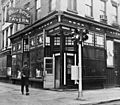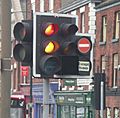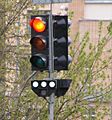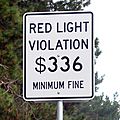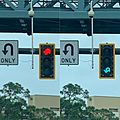Traffic light facts for kids
Traffic lights (also called traffic signals) are special lights that help control how vehicles and people move on roads. You usually see them at places where roads meet, called intersections, or at crossings where people walk across the street. The different colors of these lights tell drivers and pedestrians what they should do to stay safe.
Contents
How Do Traffic Lights Work?
Traffic lights always change their colors in the same order. This helps everyone know what to expect. In most places where people speak English, traffic lights usually follow this pattern:
What Each Light Means
- Red light: When the red light is on, it means all vehicles must stop. Drivers should stop before the white line on the road or before the pedestrian crossing.
- Green light: A green light means drivers can start driving or keep going. It's safe to move through the intersection or crossing.
- Yellow light: The yellow light comes on after green and before red. It tells drivers to slow down and get ready to stop because the light is about to turn red. If a driver is too close to the intersection to stop safely, they can continue carefully.
Who Invented Traffic Lights?
Many people helped create the traffic lights we use today.
Early Inventors of Traffic Signals
- Lester Wire is often given credit for inventing the first electric traffic light in 1912. He created it in Salt Lake City, Utah, in the United States.
- Garrett Morgan, an African-American inventor, also created a traffic signaling system. He was one of the first people to get a patent (a special legal right) for his traffic light design.
- William Potts, who was a police officer, invented the first traffic light that used all three colors: red, yellow, and green.
Images for kids
-
A traffic light for pedestrians in Switzerland.
-
An early two-light traffic signal near White Horse Tavern in Hudson Street, New York, taken in 1961.
-
A traffic light in Stockholm in 1953.
-
Traffic lights can have extra lights for turning or for bus lanes. This one was designed by David Mellor in 1965 and is used in the United Kingdom and other British areas. It also shows a red and orange light combination.
-
A traffic light for pedestrians showing Miffy and a white LED countdown to green in Utrecht, Netherlands.
-
Traffic lights specifically for bicycles in Vienna.
-
A Swedish traffic light (left) only for public transport vehicles. These signals use white lights and special symbols ("S", "–", and an arrow).
-
A traffic light in Westbrook, Maine, on State Route 25. Notice the red arrow for turns.
-
A historic dummy light in Canajoharie, New York, United States.
-
An example of a modern LED traffic light in Australia.
-
A temporary traffic light near Hazlerigg, England.
-
California tries to stop people from running red lights by showing the minimum fine.
-
A traffic light in Chelyabinsk, Russia showing a green light with a digital countdown of the time left.
-
An intersection with blue confirmation lights in Newport News, Virginia.
-
A traffic light with a timer in Tehran, Iran.
-
An example of a wire-mounted traffic light in Fort Worth, Texas.
-
A typical traffic light on Ninth Avenue in New York City.
-
A traffic light mounted vertically in Boston.
-
An example of a horizontally mounted traffic light in Trenton, New Jersey.
-
A large, strong metal traffic light structure in Florida that can resist hurricanes.
-
Angled mast-arms, often used in Pennsylvania during the 1960s and 1970s.
-
Three horizontally mounted traffic lights for better visibility under a bridge in King of Prussia, Pennsylvania.
-
A traffic light in a small intersection in Hagerstown, Maryland.
-
Traffic signals mounted on gantries in downtown Cincinnati, Ohio, integrated with street signs.
-
A typical set of traffic lights in East Lansing, Michigan.
-
One example of traffic lights on a suburban street in Santa Clarita, California.
-
LED traffic lights in Örnsköldsvik, Sweden.
-
A traffic light in Ashgabat, Turkmenistan.
-
A Marshalite traffic signal, once used in Melbourne, Australia, showing how much time was left before the light changed.
-
A U-turn traffic light in Lake Buena Vista, Florida.
See also
 In Spanish: Semáforo para niños
In Spanish: Semáforo para niños




